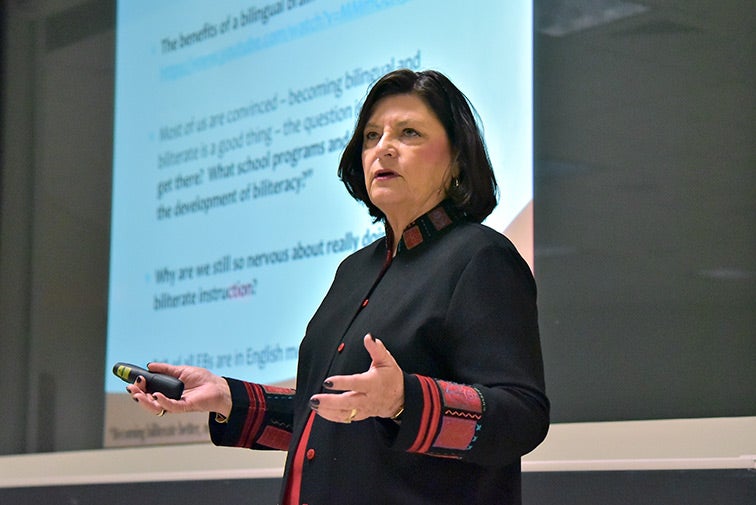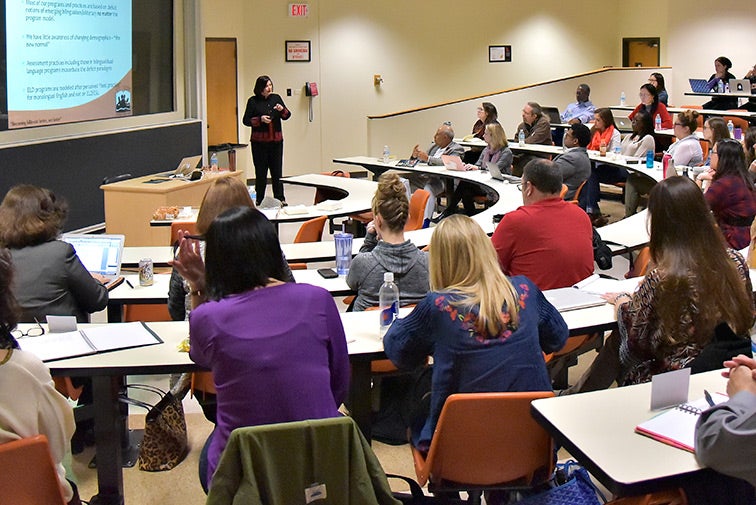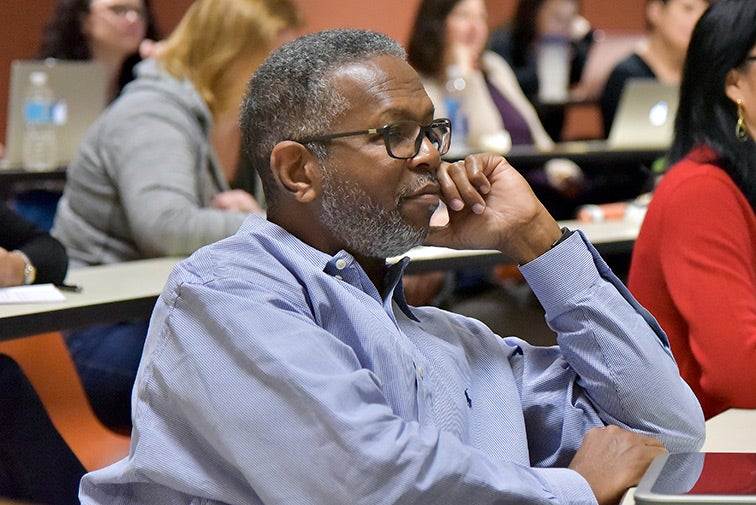The Department of Curriculum and Instruction welcomed Dr. Kathy Escamilla on February 17th as part of its Spring Teacher Education Forum for graduate students and faculty. Dr. Escamilla, the Bob and Judy Charles Endowed Chair of Education and Professor at the University of Colorado Boulder’s School of Education, delivered an engaging presentation about new research and best practices regarding bilingual and bi-literate education as part of this unique professional series that brings together faculty, clinicians, researchers, and graduate students.

of Colorado Boulder’s School of Education,
presents at the Spring Teacher Education Forum.
This and other presentations on cultural and linguistic diversity in education are critical to the Department of Curriculum and Instruction’s commitment to serving teachers and students. “It’s always very exciting when we get together as teacher educators,” says department chair Dr. Cinthia Salinas. “Bringing in someone like Dr. Escamilla unites us and reifies our vision of what it means to serve.”
A veteran of the classroom, Escamilla began her career teaching with Headstart and the Colorado Migrant Council in the early 1970s. Now, as leader of the Literacy Squared project used by districts across the country—including Austin ISD—Escamilla urged her fellow academics to stay connected to what’s going on at ground level. “I spend as much time as possible in Denver schools,” she noted. “It’s so important to stay in touch.”
That connectivity has helped Escamilla pinpoint certain facts that prove especially helpful to teachers in any classroom where bilingualism plays a role. High stakes testing has instilled a nervousness that, Escamilla says, pushes teachers to use English-only instruction in hopes that it will better serve students learning the language. But the facts contradict a mono-linguistic methodology.

and Instruction meet regularly to stay
current and inspired by thought
leaders in their field.
According to peer-reviewed research, bilingually educated students have greater cognitive flexibility, memory, executive function, measurably better family relations, and fewer problems in school when compared to their monolinguistic counterparts. Bilingual students are more likely to graduate and go to college, among other promising data. Plus, 67 percent of all children who enter U.S. public schools are classified as emerging bilinguals—a statistic that describes only children born in the U.S. So, if the majority of young U.S. public school students are speaking two languages, what accounts for the perception that simultaneous bilingualism is a deficit?
One important reason, says Escamilla, is that educators are used to thinking about language acquisition from a sequential bilingual perspective, i.e. children become fluent in one language before acquiring another. But that’s just not true for most bilingual students, who learn Spanish and English at the same time.
Normal bilingual behaviors may be viewed as sub-level performance if a teacher fails to understand how a student with lifelong exposure to two languages often uses code-switching techniques to communicate. “All language is learned in context,” says Escamilla. “There’s a gap between what we know and what we do. Most assessment practices exacerbate the notions of deficit paradigms. ‘They don’t speak real Spanish’ or ‘they don’t speak real English’.”

clinicians, and graduate students, consider
the lessons presented by education
expert Dr. Kathy Escamilla.
The solution, as outlined by the curriculum in Escamilla’s project Literacy Squared, ensures assessments value the cognitive work students are doing across languages, what is called “interlanguaging.” Interlanguaging is using language that was learned in context, e.g. a student learning colors in an English classroom and using the English word within a Spanish sentence. When assessing the work of children who speak two languages, Escamilla argued, we have to use an appreciative lens to notice what the students are doing with both languages together.
For the teacher educators in the room, the implications of Escamilla’s research were clear: Decisions about assessment and instruction have especially high stakes for students who are emerging and simultaneous bilinguals. It is more important that ever, given the diversity of linguistic backgrounds of young students across the country, to put aside preconceptions about language learning and examine what it truly means to learn and grow as an interlanguaging bilingual student.
Photos by Zoe Fu

